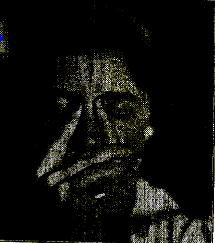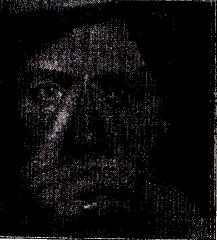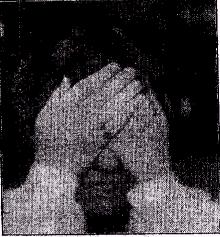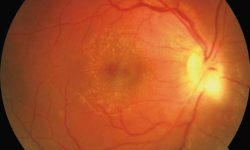New York Medical Journal, Feb. 3, 1917, pp. 200-202.
A woman, fifty-four years of age, was first seen by me on May 9, 1915. Her son, who guided her into the office, stated that his mother had been “going blind” for a long time; that she could not see to find her way about the house; that she was unable to see the faces of people around her, and that she could not attend social gatherings with comfort. When out of doors she required the services of an attendant because of her inability to see passing people, obstructions on the sidewalk, or the curbstones or vehicles at street crossings.
The patient’s husband, a banker, and a man of intelligence and accurate observation, gave the the history of her progressive loss of sight. During the past twenty-five years he had consulted numerous oculists in various parts of the United States, each of whom had pronounced her condition incurable.
I am indebted to G. de Wayne Ballet, M.D., of New York, for the ‘Following record of the patient’s condition when she was under his care:
July 7. 1910. The patient gave a history of failing vision for twenty years, first in the right eye and later in the left. The patient states that the vision is slightly worse in the left eye than it was two years ago. She said: “Everything is in a mist.”
Right vision, fingers counted at two feet. Left vision, 15/200.
This is a case of old neuroretinitis in each eye, a few bloodvessels left, but for tbc most part only white lines extend off into the retina in place of old vessels. She has also choroiditis disseminata in both eyes.
Rx Syr. acidi hydriodic;, 3i once each day.
July 22. r9ro. To read she has used a strong hand magnifying glass besides her spectacles. When tested she read Jaeger No. 2 vith +10.00 D.S. with the left eye only and she likes it . This glass was prescribed for the left eye.
September 21, 1011. Left vision, 10/200. Ordered for near vision, +12.00 D.S.
Cocaine was used in each eye to dilate the pupil in order to examine the fundus. Can see no change since the last examination.
Treatment: Continue the use of the hydriodic acid.
Following this period of observation by Doctor Hallet, the patient consulted other physicians as stated, always being given an unfavorable prognosis.
The patient was treated by me for the following conditions: incipient cataract; vitreous, cloudy with floating bodies; neuritis, with partial atrophy Of the optic nerves; retinitis, with obliteration of many blood vessels; choroiditis disseminata; glaucoma of the left eye, connective tissue in the anterior chamber of the left eye, obscuring the iris and pupil; functional myopia; functional divergent and vertical squint.
The vision of the left eye, on May 9, 1915, was 5/200, field contracted. This was reduced to the perception o£ light, two days later, by air attack of acute glaucoma. Nliotics, eserine, pilocarpille eye drops failed to relieve the tension and pain after three days; since then they have not been used.

Fig. 1. — Nose pressure, with the eyes closed, the patient imagining or remembering the black period.
With the assistance of Dr. C. Barnert, an iriclectomy was performed. The pain and tension were relieved for a time, but the vision %vas not improved. Hemorrhages into the anterior chamber occurred on different days during the following week. A mass of connective tissue replaced the blood clots in the anterior chamber, and was large enough to obscure the iris and pupil. Dionin, ten per cent. solution, was instilled six times daily, and the powder once daily in the left eye only. The solution of dionin is still being used in the left eye only.
Later the patient had a number of mild recurrent attacks of glaucoma in the left eye, with pain and increased tension. After three months the tension remained normal. The tension of the right eye subsequently was increased at intervals, always subsiding at once after central fixation was obtained.
My experience with this case, and with others of various degrees of severity, has convinced me that the value of central fixation in the treatment of acute, chronic, and absolute glaucoma should be emphasized. Central fixation, as utilized by me, has relieved the symptom of glaucoma after operative and other treatment had failed. The-value of the nxethod employed in this case has been demonstrated in many other cases, and in various conditions other than glaucoma, of organic as well as of functional character.
The treatment described by me [1] with certain modifications, was employed in the case here cited, and was found beneficial, as will be seen. Memory and the imagination were useful. A small black spot or period on the Snellen card was imagined. When the sight was poor, at the beginning of the treatment, the period imagined was imperfect. The problem for this patient was to imagine the period as perfectly black and stationary at all distances; then to be conscious of seeing a part or all of a letter without losing the period. The memory or imagination of a black period, at all times and in all places, secured for this patient unusual benefit.

It was explained to her that by “central fixation” is meant a passive, receptive, or relaxed condition of the eyes and brain. When the mind is sufficiently at rest the eye sees best the point fixed — in other words, the eye sees best what it is looking at. With the passive, receptive, relaxed condition of the eyes and mind, or with the absence of strain or effort, as manifested by central fixation, the sight was always unproved. The myopic refraction produced by all effort to see distant objects and the hypermetropic refraction produced by an effort to see near, were absent when the eyes became relaxed and central fixation was manifest. Color blindness, contracted field, pain and fatigue, and photophobia were also materially benefited or cured. The objective symptoms of increased intraocular tension, squint, strain of the muscles of the face, twitching of the eyelids and eyeballs, all disappeared instantaneously when the patient was conscious of central fixation_ The organic lesions were seen to improve. With the hlood vessels the changes were slow: but with the cloudiness of the lens, central fixation was followed immediately by an increased transparency readily demonstrated by the ophthalmoscope.
In six days the sight of the right eye had improved to more than one tench of the normal. Later, the patient became able to travel on the subway alone, to shop in the neighborhood of her home, to read and write letters, and to read hooks, amgazines, and newspapers. She becarne able to see the color of the eyes of her husband, chii1dren, and friends, which she had never been able to do before in her life. Her sight at night also improved, so that she saw the lights across the Hudson River, stationary and moving, more than a mule away. She won first prize at auction bridge twice, enjoyed theatres and moving picture shows, went to parties, receptions, dinners, and other social functions, and had a good time.
January 17, 1916. Patient went out of doors alone or without an attendant, and took a walk on Riverside Drive.
Fehmary 23, 1916. She is beginning to distinguish colors. Without an attendant she walked alone from her home at 142nd Street and Broadway to the subway station at 145th Street, thence went by train to the Grand Central Station, walked over to the uptown side, and returned home on the train.

March 3, 1916. Went to the theatre and enjoyed the play.
March 6. 1916. Plays cards. Tells the time with the aid of her small watch without glasses.
April 1, 1916. She won first prize at are auction bridge card party. With the eyes closed she believes that she can now imagine as vecll with the left eye as with the right, indicating an improved condition of the left retina.
April 6, 1916. Won second prize at auction bridge, 140 players.
April 18, 1916. Read a column of the New York Times, news seetian.
She sees the Hudson River boats, and houses and trees across the river; Lights on the boats were seen at night, but not the lights on the apposite shore.
April 28, 1916. The patient is beginning to read diamond type, Jaeger No. 1, at six inches, using two of her fingers as a pointer.
May 6, 1916. The new moon and the stars were seen for the first time.
May 15, 1916. The lights across the Hudson River, more than a mire distant, were soon when the room occu- pied by the patient was dark or the lights turned off. (Later, )une 2t, she was able to sce the distant lights with the room occupied and well lighted.
May 20, 1916. Patient was able consciously, at will, to produce the illusion of seeing one object as iwo or more — monocular polyopia, by a strain, eccentric fixation.
June 21 1916. Did some sewing with a split needle. R.-, 14/30, without the consciousness of the black period. She runs short: distances on the street without difficulty.
July 1, 1916. The patient writes letters without glasses better than with them, because she fends her sight confused with glasses. Tbe imagination or the memory of a perfectly black period relieves or prevents the pain which is usually produced by the instillation of the dionin powder into the left aye.
August 1, 1916. With the right eye a line of diamond type was read in five minutes, wlthrut glasses and without the aid of a pointer.
August 8, 1916. The left eye distinguished one letter of diamond type for the first time, without glasses, at six inches.
Angust 15, 1916. Diamond typo, one line read in forty seeonds.
August 31, 1916. With the right eye one line of diarrtond type was read is six seconds, without the aid o£ a pointer. With the left eye after some minutes one letter was seen with the aid of a painter. For the first time the color of her own eyes was seen with the aid of a mirror.
The progress noted may be stunmarixed as follows:
May 9, 1915. R., p. L; L., 5/200.
May 11, 1915. R., p. L; L., p. 1., glaucoma.
May 17, 1915. R., 14/200; L., p. 1.
June 6, 1915. R., 14/50-; L., p. 1.
October 15, 1915. R., 14/50-; L., 14/200.
November 21, 1915. R., 14/50+; L., 14/200.
May 12, 1916. R., 14/10+; L., 14/200.
June 17, 1916. R., 14/10+; L., 14/50.
July 14, 1916. R., 14/10+; L., 14/10-.
August 31, 1916. R., 14/10+ or 20/10-; L., 14/10-.
The vision of the right eye was improved from p.1. to 14/200 in 8 days; 14/200 to 14/50- in 20 days; 14/50- to 14/15+ in 168 days, or 5 1/2 months; 14/15+ to 14/10+ in 185 days, or 6 months.
The vision of the left eye was improved from p.1. to 14/200 in 157 days, or 5 months; 14/200 to 14/50 in 246 days, or 8 months; 14/50 to 14/10- in 27 days.
In a letter received some months after she left New York, the patient wrote: “I do not think I have gone hack any. I see very well indeed. Recently I saw in the garden, about one hundred feet away, a yellow butterfly alight on a red flower. My letters are written without lasses. The right eye really seems improved, but the left eye has not changed. I still use the dionin eye drops in. the left eye only.”
This case has been of special interest because it has demonstrated that central fixation, previously utilized in the treatment of functional disease of the eye, is also of distinct value in the treatment of certain organic diseases of this organ. Many such cases, which, treated solely along the lines of the customary ophthalmologic practice, would be consigned to the category of the practically hopeless, may he markedly benefited, and restored to active and useful life.
40 East Forty-first Street.
Reference
- BATES: New York Medical Journal, May 8, 1915.
get help on our Facebook Group!

In the early 20th century, Dr. Bates began noticing that the vision of some patients would vary and that some would see better after not having worn their glasses or by resting their eyes in certain ways. Through many years of clinical and experimental work, he learned what things are restful to the eyes and cause the vision to improve, and what things cause vision to worsen and even cause further complications with the eyes.

I wonder if people with cataracts can benefit from the bates method and not have surgery? Also, is it possible for someone born blind to have site or some site? Must they have been able to have sight to recall in order to improve or have any vision at alk? Thanks
There is some info on cataracts here. Anything is possible!
https://www.iblindness.org/929/natural-treatment-for-cataract-without-surgery/
Thank you very much.
Bates and his assistant Emily Lierman found that people born blind who consequently had no visual memory or imagination could gain at least some vision through their sense of touch. Even people born blind hopefully have tactile memory and imagination and this may well be of benefit when properly used. Bates said that a blind man will, if you let him, tell you of the marvellous variety of colours and forms that he sometimes will ‘see’. Bates also said these kinds of illusions may be used to start restoring vision. With patience and proper practice we will hopefully get really good benefits.
Related to this topic are a few instances in the Bates Magazines where we are told that some patients, who ‘ought’ to be blind due to the eye’s lack of a macula, and so on were able to see without their physical eyes, mysteriously by some other means. This is so mysterious and yet I don’t doubt it for a second. It seems to be a case of not “we see very largely with the mind and only partly with the eyes” but in rare cases, “we see totally with the mind…”. This phenomenon has been reported outside the Bates Method sphere and there is a book by a Herbert Thurston about it in part and he was regarded as an authority in his field. Bates in the March 1921 magazine mentions an account where a patient told him of a blind friend who (without Bates knowledge) became able to see through the memory of a grey cloud and his vision was permanently restored. These two paragraphs are extraordinary, and end “Doctors who have examined his eyes since say he still has atrophy of the optic nerve and ought still to be blind.” Wow.
I think it’s a useful practice for people to treat their eyes’ vision, particularly blurry vision, as merely a helpful data gathering tool, not taking it too seriously, and putting their attention more into the images in their mind of what all the objects might look like perfectly clear, as well as the distance and form. That way blind people can visualize all kinds of stuff if they get into the right state. I imagine that some of what they “see” is very accurate, due to our latent perceptive abilities, while other stuff is images mixing in from their thoughts.
This case history is not an isolated incident. The authority of hope has a great power. An inspiration that intuitively guides possible direction. The source of that direction may actually be the sufferer. Ability to connect to that source and trust is the one in service. That process is unique, is energizing and has no doubts. Optimal results humbling.
Hello, I not unterstand what is the method can someone explain me?